Kitchen Project #149: French Yoghurt Cake
A big HELLO to The Condiment Book by Claire Dinhut
Hello,
Welcome to today’s edition of Kitchen Projects. Thank you so much for being here.
You know I love a book special, and this week, I am so excited to tell you all about my favourite cookbook of the season, ‘The Condiment Book’ by Claire Dinhut, which is out this week. I genuinely love this book and can’t wait to tell you more about the world of flavour within, along with a Q&A with Claire. I am also very excited to take a deeper look at the legendary French Yoghurt Cake, a ratio cake of dreams that EVERYONE can make.
For KP+, thanks to Claire, I have been thinking a lot about condiments + cake… and, so you don’t have to, have been experimenting with mayonnaise IN cake. AGHHH - it feels wrong, but some pastry chefs swear by it! You can read about that and get my version of the French Yoghurt Cake (this time, it’s rich, chocolate chip and possibly one of the best, most tender cakes I’ve ever made even though I DIDN’T EVEN USE A SCALE TO MAKE IT - I am still in shock, trust me!). Click here for the recipe.
What’s KP+? Well, it’s the level-up version of this newsletter. By joining KP+, you will support the writing and research that goes into the newsletter (including the commissioning - and fair payment - of all the writers), join a growing community, access extra content (inc., the entire archive) and more. Subscribing is easy and only costs £6 per month or £50 for the whole year. Why not give it a go? Come and join the gang!
Love,
Nicola
A Love Letter to Condiments
Take a moment to think of all your favourite meals. Go on, imagine it. Maybe you’re thinking about a steamer basket full of xiao long bao, or perhaps you’ve conjured up a Sunday Roast. What about a crispy fish taco or a plate of spaghetti pomodoro? Now, imagine a world where the xiao long bao comes without the sharp black dipping vinegar, the Sunday Roast without gravy, the fish taco without pickles, hot sauce and salsa and finally, cruelly, a world of pasta without parmesan. EVER. Sound bleak? Well, that my friends, is the power of condiments.
Published this week is ‘The Condiment Book’ by Claire Dinhut, aka Condiment Claire. It journeys into the world of—as the subtitle puts it—‘Food's Unsung Heroes’—the jars and bottles we rely on to bring our food to life. Whether we’re spreading jam on toast, throwing miso into caramel, or whisking up a salad dressing with a generous spoonful of mustard, we owe a lot to our condiments.
Finally, in this gorgeous book, they get the spotlight they deserve. With charming, funny prose and beautiful design, it’s so easy to get lost in this book, and it’s a genuinely useful book for anyone curious about flavour (It’s been so wildly popular, in fact, that at the time of writing this piece, it is sold out! But fear not, a restock is on the way, and the quickest way to get your hands on a copy is to put your order in now so it ships as soon as possible. You can also find it in independent bookshops - and we love indies here!)
But before we get into it… what actually IS a condiment? On page 12, Claire explains that the “word derives from the Latin verb condire, which means ‘to preserve, pickle, season, spice, render pleasant or enhance flavour’. A ‘condimentum’ itself in the Roman Empire would have been any sauce, seasoning, spice, relish or sweetener.” Basically, it’s anything ‘extra’ that we put on a dish - a splash of Worcester sauce on cheese on toast or the fragrant herbs we add to a bowl of pho.
Packed with beautiful illustrated doodles, maps and useful charts, Claire takes us through the extraordinary history of condiments, from ketchup (not originally made with tomatoes!) to butter (a journey back to 8,000 BCE), mayonnaise (the result of an 18th century war victory) to hot sauce (loved by the aztecs as both a weapon and a pleasure!), along with a series of guides on how to make your own, from tomato and vanilla basil jam to puttanesca ketchup. There’s also a series of ‘condiment companions’, like the legendary French Yoghurt Cake (which I’ll share below) so you can readily enjoy your favourite condiments, no matter what time of the day it is.
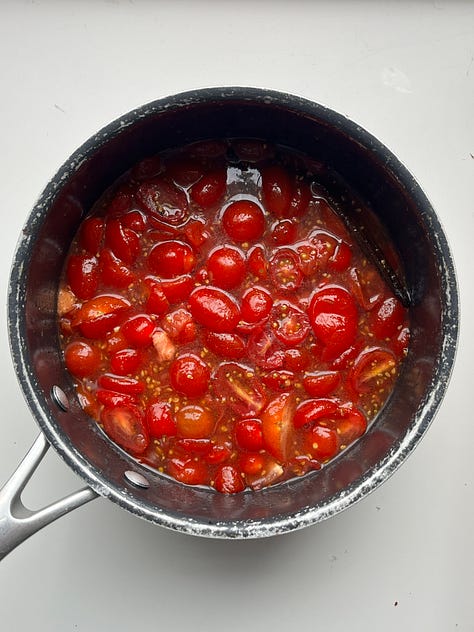
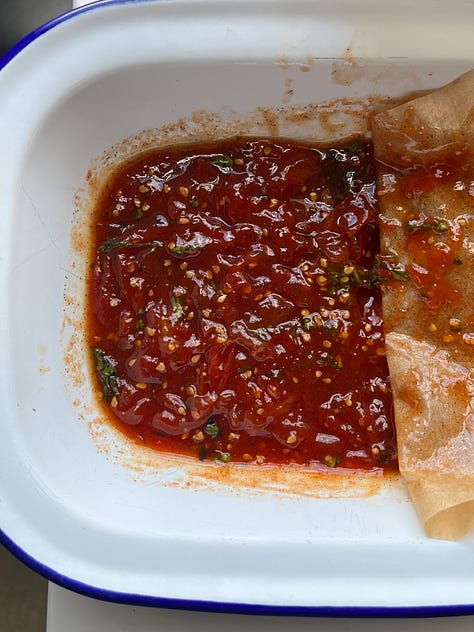
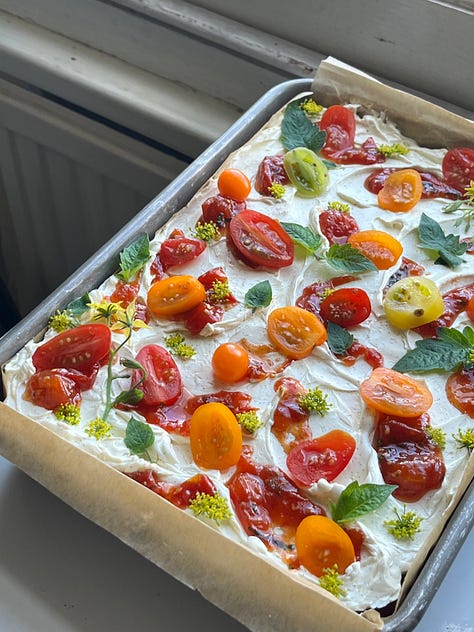
BUT - as she tells us on the very first page, The Condiment Book “is NOT a cookbook” but instead, “a flavour manual.” Though her recipes work beautifully - and I can attest to that having followed plenty of them from this book and her substack - and have clear, generous instructions, Claire’s mission is to get us all to think about flavour pairings and above all, have fun, experiment and take chances in the kitchen. While she provides a recipe for ketchup, she is never going to rip your beloved Heinz away from you - the point of this book is not to encourage you to spend more time in the kitchen to produce your own range of sauces, but to tell you the components so you can efficiently dispatch all those bottles and jars to their greatest effect.
Condiments are all about achieving maximum flavour with minimum effort. Of course, Claire vouches for mustard with pork chops and apple sauce, but she also vouches for enjoying grapes with grainy mustard, adding dijon to scrambled eggs, or making your next batch of hummus with it.
The goal of the book is to teach you about what your condiments can do for you - whether it’s adding heat, crunch, bitterness, salt, fat, brine, warmth or sweetness - and to cast aside your preconceptions about how things should be eaten. Soy sauce on vanilla ice cream, which combines rich salt flavours with fat not unlike a salted caramel (but this combo is more fun thanks to the fermented funk!) is one of Claire’s favourite combinations and I think it will be one of yours, too.
A deeper look inside the book + Q&A
With US, Greek and French heritage, it’s perhaps not a surprise that Claire Dinhut ended up in the UK, a country vaguely in the middle of ‘mish-mash’ background. Arriving here in 2020, her first interaction with a particularly famous British condiment pretty well sums up her attitude to flavour. “I had never tasted anything like Branston Pickle before moving here,” Claire explains. It was during lockdown, and she got her hands on a jar and loved how vinegary and bright it was.
With no British people to explain how to eat it or restaurants to try it at, she realised that this “vinegary and bright” pickle was the perfect companion for avocado on toast. “I didn't even know you were meant to eat it with cheddar!” Even if it confused guests at her weekend brunches, it sums up her perspective on food - that we should sometimes ignore context and instead focus on tasting things just for flavour. That way, Claire explains, we can “pair things that aren't necessarily expected, just based on what your palate likes.”
The discovery of this unlikely combination was around time that Claire Dinhut, a history & literature graduate who had been working in entertainment and TV production, became ‘Condiment Claire’, as she now known on her very entertaining, genuinely useful and educational TikTok. Though her interest in championing unlikely or underappreciated combinations has been lifelong, she has generously shared, explored and educated with her approach to cooking. She has, as a result, sparked inspiration across the world. We sat down to have a chat about what drives her to investigate flavour, and the experience of writing her debut book.
Nicola: I am very excited that The Condiment Book comes out in peak Autumn - what seasonal flavour combinations and ingredients in there can we look forward to using?
Claire: The four chutney recipes in my book are based on season and the autumn chutney is a spicy plum chutney. Every time I make a jar, I have to make at least four because I will go through them. You still get that fresh flavour, but you also get the warming molasses and mustard seeds spice kind of going into fall.
Nicola: I do love plums. What about apples?
Claire: You know, I like to keep it classic with the apple - the winter chutney is an apple, cinnamon, onion, shallot, raisin combination, which is really yummy. But I also think certain things are really good on their own - I make an apple jelly that is just apple. We’re so lucky that normal grocery stores here have fun varieties. I made hot pink jelly from pink kissabel apples last year.
Nicola: I love that you always say that you don’t have to make huge batches of preserves, that it doesn’t have to be a big deal.
Claire: Yes! If you go to the farmer's market and they're selling these five peaches for, what, a pound because they're about to go bad, great, buy them, make a jar. It’s so easy.
Nicola: Alright, and finally - what about your favourite pear combinations?
Claire: I think pear jam in general is the most underrated jam of all of the jams in the world. I love pear lemongrass jam. I think that's really nice and fresh.
Nicola: People like pear and ginger together, but I feel like lemongrass is like a kind of fragrant level up from ginger. So maybe it’s a good lesson for people to think about what is a classic combination they already enjoy and ask themselves ‘what's in the same family of spice?’
Claire: Yeah, it's like, do you like pear and ginger because it's spicy? Or because it's earthy or do you like it because it's fresh and it gives a kick? I know I love adding ginger to things, not necessarily for the spice level, but just because it's a gust of fresh.
Nicola: What are some of your favourite condiment-making discoveries?
Claire: I never knew that I could make ponzu at home until when I started writing this book, honestly. And I was like, you know what? Ponzu is one of my favourite condiments, I should probably know exactly how it's made. I knew what the ingredients were (dashi, soy sauce, citrus), but how would I actually do this at home? Now I prefer my ponzu because I've created this combo that's lime, lemon, and a little bit of Clementine, just for a bit of sweetness.
Nicola: What was your hardest recipe to develop?
Claire: I think the hot sauces, in general for me were probably the hardest ones - I really wanted to make a leche de tigre hot sauce. If you've ever had a ceviche, it’s the juice that's leftover - citrusy, combined with raw fish and onion. It’s so delicious - I had actually been to a ceviche restaurant with a friend last year and thought ‘wow, we could drink bowls and bowls of this marinade.’
Nicola: I’m already obsessed!
Claire: So I tried a bunch of different combinations, trying to replicate the same fishy but tangy sauce that's also spicy? And so I ended up just adding a little bit of fish sauce to one of my hot sauces and putting in a bunch of the ingredients that you would have in a traditional ceviche. That recipe took me a while, but I'm very, very happy with it.
Nicola: I want to talk to you about the five tastes which you cover at the beginning of your book. I know that taste is only one part of the story, and aroma is so important, but when developing recipes I often come back to those five tastes: Salt, Sweet, Sour, Bitter, Umami. Can you give us some condiment inspiration for each of those that we can incorporate into our recipes?
Claire: For salt, I’m always going to suggest soy sauce. For bitter, adding ground coffee or a splash of espresso is always great - zest adds bitterness, too. For sweet, you can look to herbs and spices - Tonka and Woodruff both add almondy and hay-like flavours that really add to a sweetness level. And maple syrup is underrated in the UK. For Umami, I think bay leaf really adds a savoury note, and I had rosemary in whipped cream the other day that was great. And sour, I love yuzu, but also sea buckthorn.
Nicola: You are doing a condiment collaboration box with Grá Chocolates (an artisan chocolatier based in Galway, Ireland - the box launches October 3rd!) with flavours like honey mustard dijon and blackberry balsamic. What did you learn about pairing flavours with chocolate from working with the team there?
Claire: I was really surprised by the experience because we’d try three different variations of each chocolate, comparing the same filling flavour with dark, milk or white chocolate casing. The flavour inside was so different based on what level we did. For example, with the tomato vanilla jam with a basil ganache, with the milk chocolate, you tasted the basil and you tasted the freshness, whereas with the dark chocolate, it tasted like marinara sauce. It was so horrible, and it was surprising that something so gross could then taste so delicious just based on the level of chocolate.
Nicola: I think a layer cake is the ultimate example of how baking is filled with condiments - everything we build a layer cake with, the buttercream, the fillings, the decorations, are all effectively condiments in that context. What is your favourite cake condiment?
Claire: I'm so American, I love buttercream. But otherwise, rainbow sprinkles.
Nicola: Are there any things that we should be using as sprinkles? Anything can be a sprinkle right?
Claire: I mean, this is pretty obvious, but any toasted salted nut can be a sprinkle.
Nicola: What about furikake? Furikake looks like sprinkles!
Claire: I made chocolate chip seaweed cookies the other day and they were so good. Because it just added a level of savoriness that ended with the brininess.
Nicola: Ooh, maybe seaweed is the next hot salty ingredient! What is something that you hope people will learn from your book?
Claire: Here's the thing. There's taste and there's flavour. Taste is salty, sweet, bitter acid, umami but flavor also includes with nostalgia, memory, colour, and texture. It always comes down to choosing your own adventure - I’ll give you a guide, but figure out what you like - are you more lime? Are you more lemon? Are you more orange? Clementine? All of that? Go bergamot! Go crazy!
Nicola: Is there a recipe you are most excited about sharing with the world?
Claire: I think I'm most excited probably about my tomato vanilla basil jam because I think not only is it just delicious, I think it's also exciting in the sense that it can teach people that you don't necessarily need always to make jam with traditional jam ingredients like fruit. In the trajectory of ketchup, it isn’t always made with tomatoes. You know, it's been anchovy, mushroom, banana ketchup. So, with this tomato vanilla basil jam, I think it'll also teach people not to be afraid. To experiment a little more.
Thank you Claire! I know that The Condiment Book is already one of my favourites in my collection (get yours here!) and I’m excited to get into details about the French Yoghurt Cake, a recipe that Claire has been making all her life and is one of her ‘condiment companions’ in the book. Let’s do it!
French Yogurt Cake
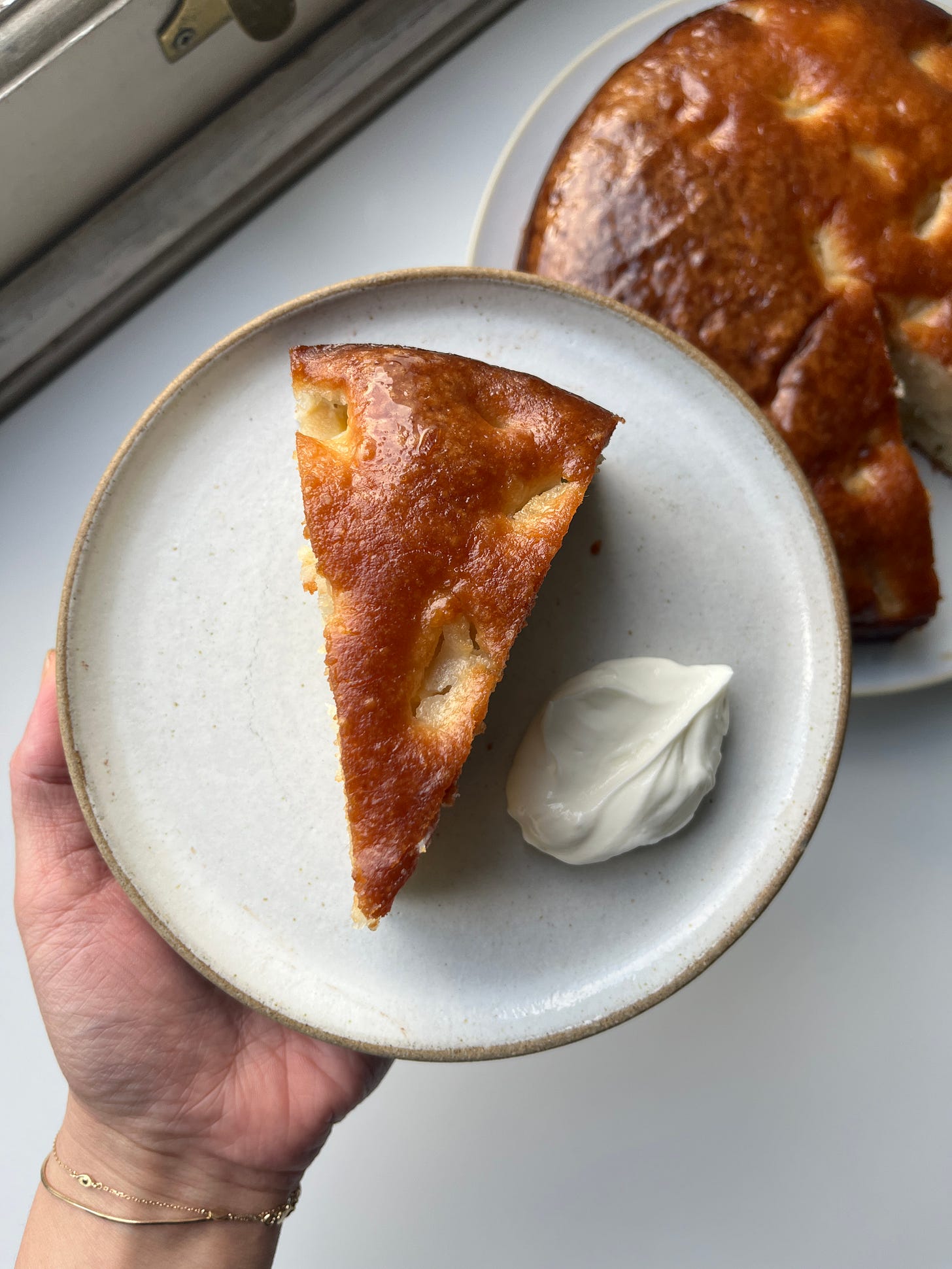
I’m no stranger to ratios in baking - you know I love a 1:2:3 crumb, and let’s not even start with how good a 1:1 ganache is. BUT, volumetric ratios? I’ve spent much of my career fighting against recipes that use volume measurements, preferring to give you measurements down to the gram. But, I will concede that there are certain environments where volume is acceptable, and the ‘French Yogurt Cake’ is one of them. No, you don’t need to buy measuring cups for this - your yoghurt pot becomes the measuring utensil.
Claire learned this cake growing up, which is a right of passage for any French child - whether baking it at school, at a friend’s house, or with your parent or grandparent. “Every single kid is taught to make it in France”, she explains, “every single kid grows up with that flavour.” The key is its simplicity: One pot of yoghurt, two pots of sugar, three of flour and so on. And Claire’s favourite thing about it, beyond the nostalgia, of course? “It always works!” Even if you adjust it with cocoa powder or throw fruit in (which, by the way, Claire reassured me ‘won’t sink’!), you get a reliable, delicious result.
 Tiktok failed to load.
Tiktok failed to load.Enable 3rd party cookies or use another browser
Now, I am not telling you to throw away your digital scales anytime soon, but there are times when you want to make a cake, and you don’t have access to a scale. Last summer, I made this yoghurt cake for my mum’s birthday when we were staying in a remote Air BnB in Wisconsin; It was a total birthday saver. It makes a denser, firmer cake that feels totally appropriate for afternoon tea (or maybe goûter - the 4 pm afternoon snack in France). It can be baked in a round tin or as a loaf and welcomes additions like lemon zest and juice (‘pretty standard’ in the classic, according to Claire) or spices as the seasons change.
In France, yoghurt cake seems to be as commonplace as digestive biscuits are here in the UK. “It's just something that you have,” Claire explains. “Any birthday party will probably be a yoghurt cake. If it's a chocolate cake, it's probably a yoghurt cake with some cocoa powder instead of some of the flour. It's genuinely always around.”
Of course, I had to look into exactly WHAT the ratios were, by weight, to understand this cake. Bearing in mind that the reason that volumetric measurements are so controversial is because everyone gets slightly (or very) different results when scooping/packing a measuring implement, these are the weights that I personally got, and, therefore, will be analysing:
From here, you can see that this is a relatively low-fat cake. The tenderising comes mainly from the higher sugar content and the yoghurt. The relatively high flour content makes this a denser crumbed cake, perfect for lifting and holding whatever mix-ins you desire - chocolate chips? Sure! Fruit? Let’s go! The yoghurt, with its tang, will improve lift and the reaction of the raising agents and add moisture along with the eggs.
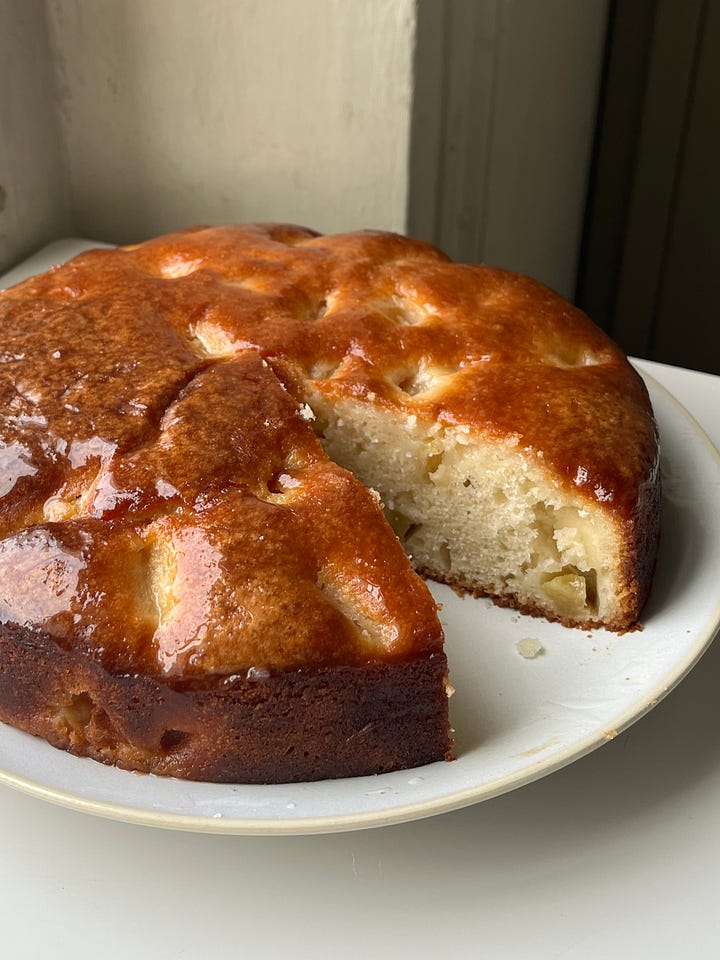
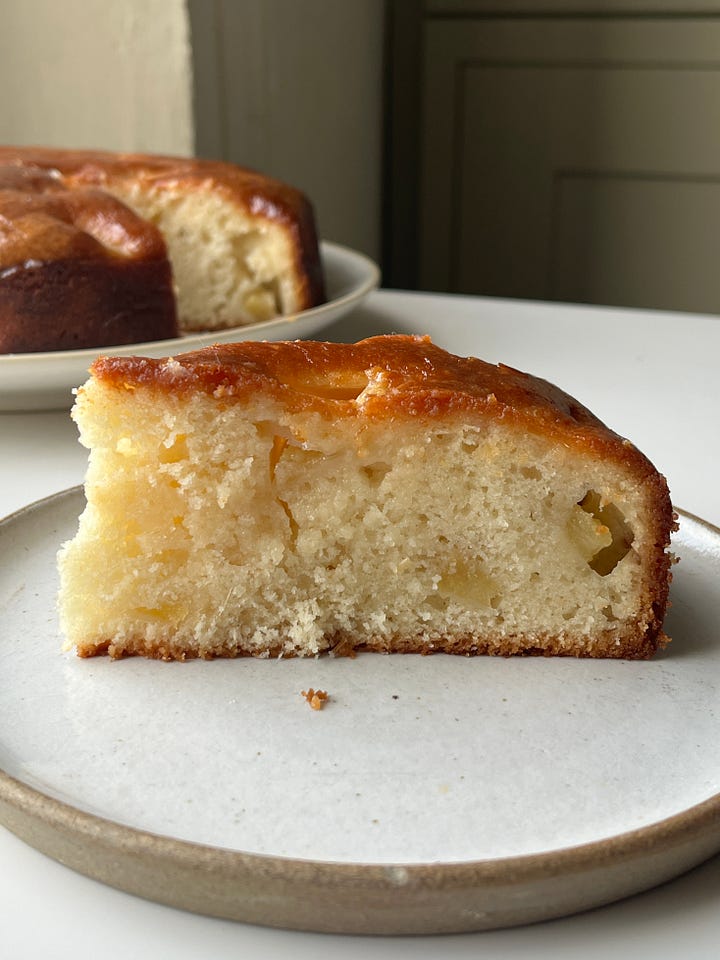
Claire reassures me that other small pots of dairy will work, too. Sour cream? Sure! Creme fraiche? Absolutely. The only thing you need to be careful of is the size of the pot (130g-150g max). Otherwise, the ratio of eggs, which are not measured by pot but by individual number, can be thrown off. Although this is definitely a simple, one-layered cake, it can be dressed up for special occasions. To celebrate Claire’s book launch this week, I made a traybake version with my salted vanilla buttercream from SIFT along with a batch of Claire’s Tomato Vanilla Basil Jam (The Condiment Book pg.87!) to adorn the top. It was the perfect combination of beautiful, freaky and incredibly easy. What’s not to love?
What about a chocolate version?
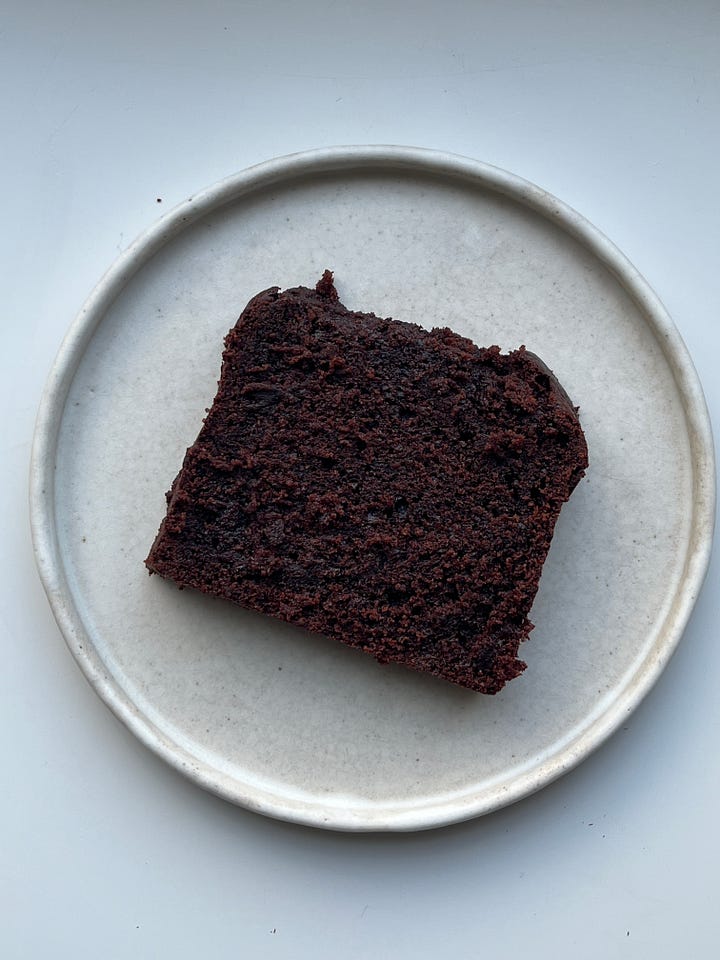
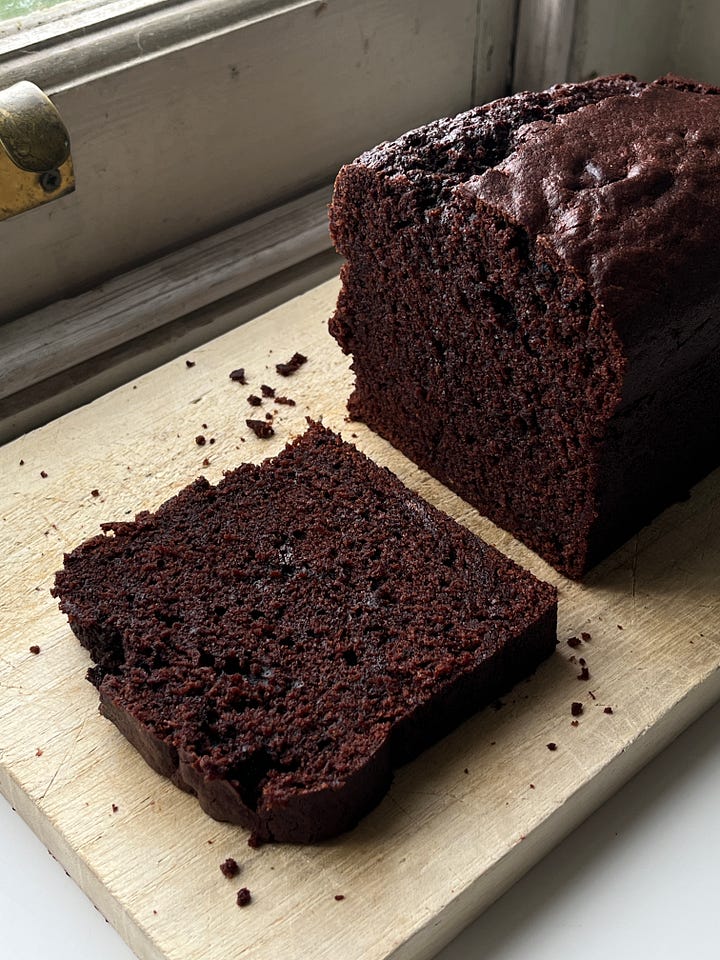
Honestly, a cake made with volumetric ratios really throws me out of my comfort zone. Isn’t it wild that I feel calmer making croissants from scratch than throwing together this one pot/bowl cake? While I’ll save the analysis for my therapy sessions, I did decide to challenge myself to create my *own* ratio cake for this week, taking on a chocolate loaf using the one-pot method. I’m thrilled to introduce you to this superbly moist, double chocolate chip loaf yoghurt cake. This is so fudgy, and such an excellent cake, I’m actually kind of annoyed that it was achieved using a simple volumetric ratio system. You can find my ratio and the recipe over on KP+, along with a deep dive into the topic of… using mayo in cakes. What a world we live in:
Alright, let’s make the ‘classic’ yoghurt cake. I’ve used one of Claire’s favourite combinations from the book, pear and lemongrass, to flavour my cake.
Pear and Lemongrass Yoghurt Cake
Adapted from The Condiment Book by Claire Dinhut
Ingredients
1 pot filled with natural yoghurt (I used FAGE 150g, 5% fat)
½ yogurt pot of neutral oil,
2 pots of caster sugar
2 eggs
1 tsp vanilla extract
3 pots of plain flour
1½ tsp baking powder
1 tsp fine sea salt
3 sticks lemongrass
300g pear, peeled and cored, chopped into 1-2cm piees (about 2 large pears)
For the syrup
Lemongrass from above (see recipe)
125g sugar
175g water
Method
Preheat the oven to 170°C fan. Grease and line a 9inch round cake tin. If you only have an 8-inch cake tin, I suggest filling it only 1/2-2/3 full and then baking any excess batter in cupcake tins, as otherwise, I can tell you from experience that this takes decades to bake.
Place the wet ingredients (oil, yoghurt, eggs, vanilla extract) in the bowl and mix thoroughly.
Remove the tough outer stalks of the lemongrass sticks and cut off the base. Reserve for the syrup. Blitz the more tender middle bits (about 20g) with the sugar until finely ground. Whisk into the oil/yoghurt/egg mixture.
Add the dry ingredients (flour, baking powder, salt) and mix again. Fold in the pear pieces.
Scrape the cake batter into the prepared tin.
Bake for 40-50 minutes or until a knife inserted into the centre comes out clean or with just a few moist crumbs. Leave to cool. PLEASE NOTE that the baking time will vary depending on your baking tin (loaf vs. pan) and the size of your yoghurt pot - a smaller yoghurt pot will make a smaller batch of cake, which will bake faster.
While baking the cake, make the syrup: Bring the ingredients together in a small saucepan to the boil and bubble for about 5 minutes until glossy. Allow to cool a little before using.
Once the cake comes out of the oven, brush it generously with syrup. It will last 3 days at room temperature. Any leftovers can be brushed onto the cake later, stored in the fridge for 2 weeks, and used in cocktails or as glazes for other cakes.


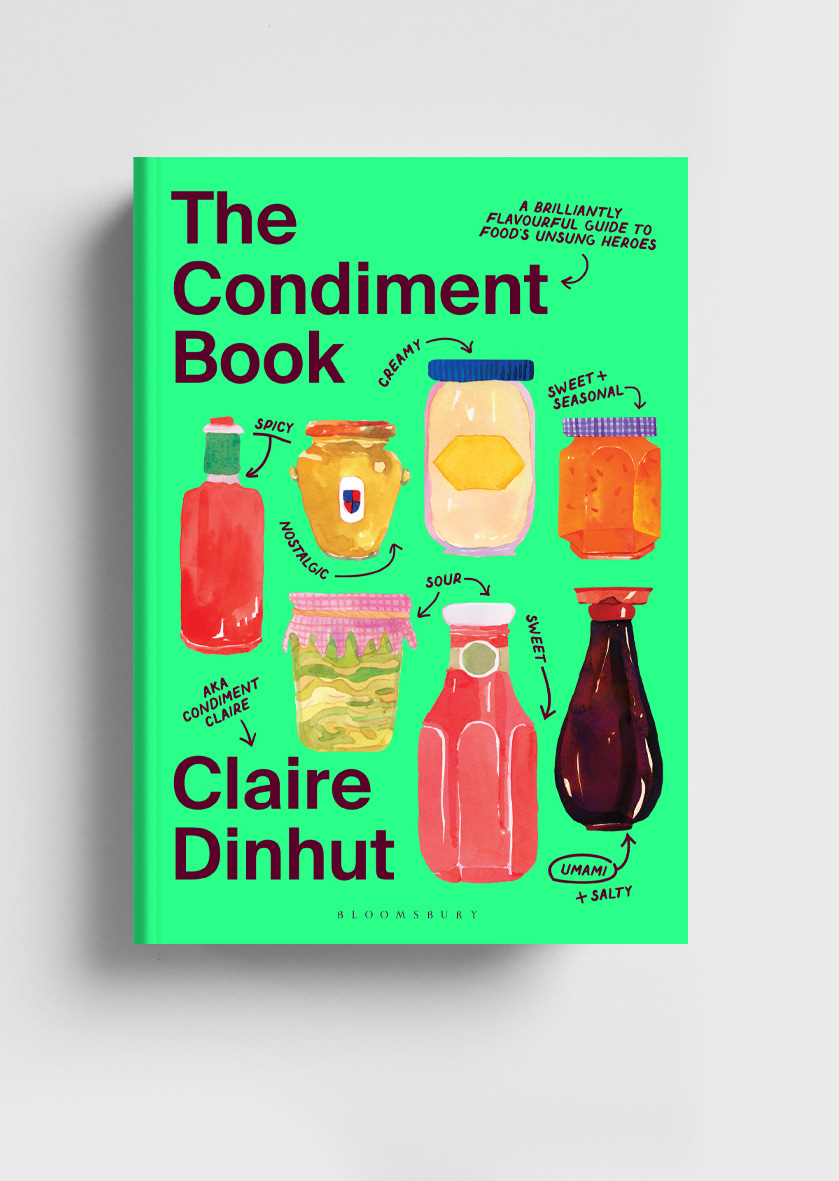
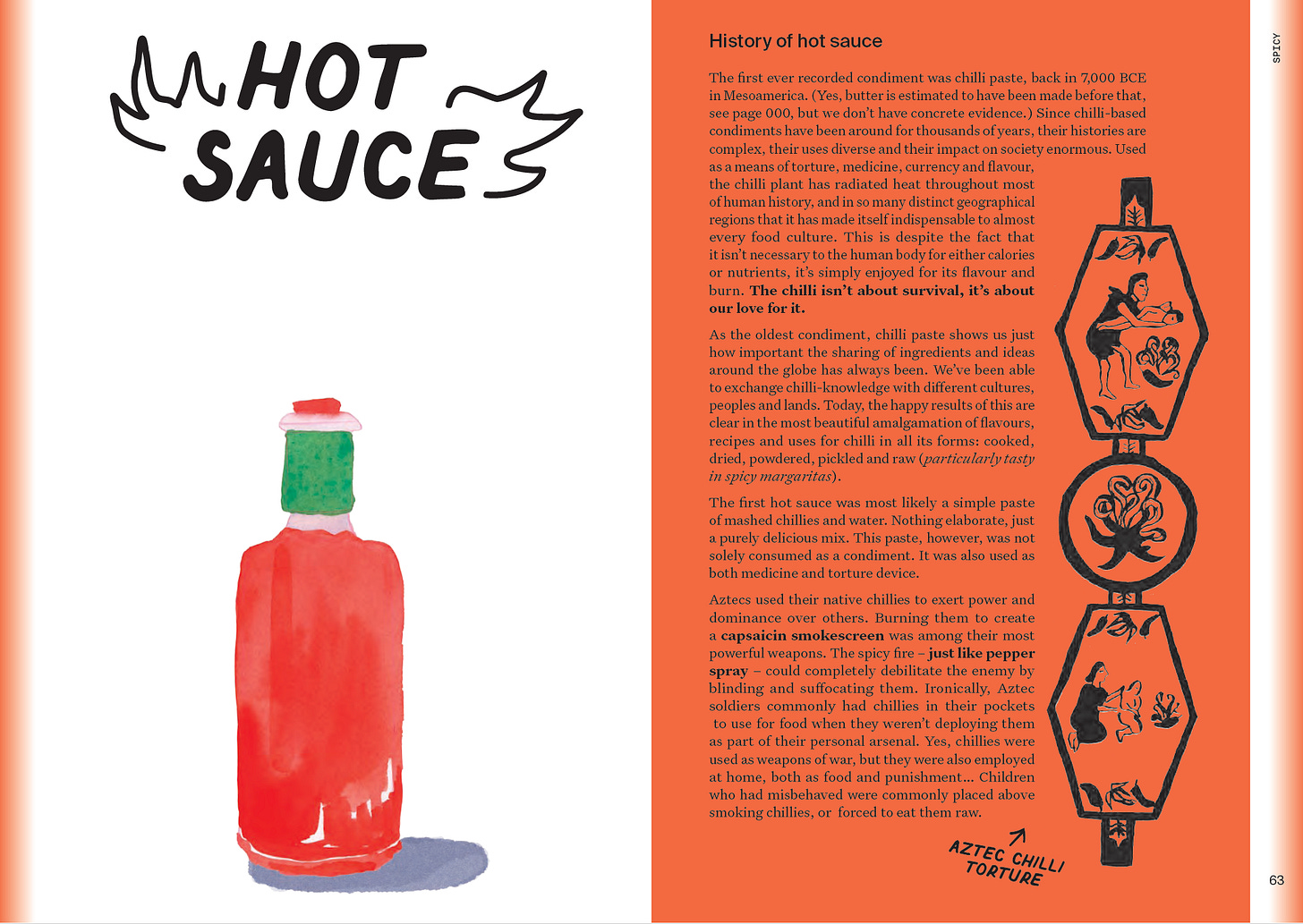
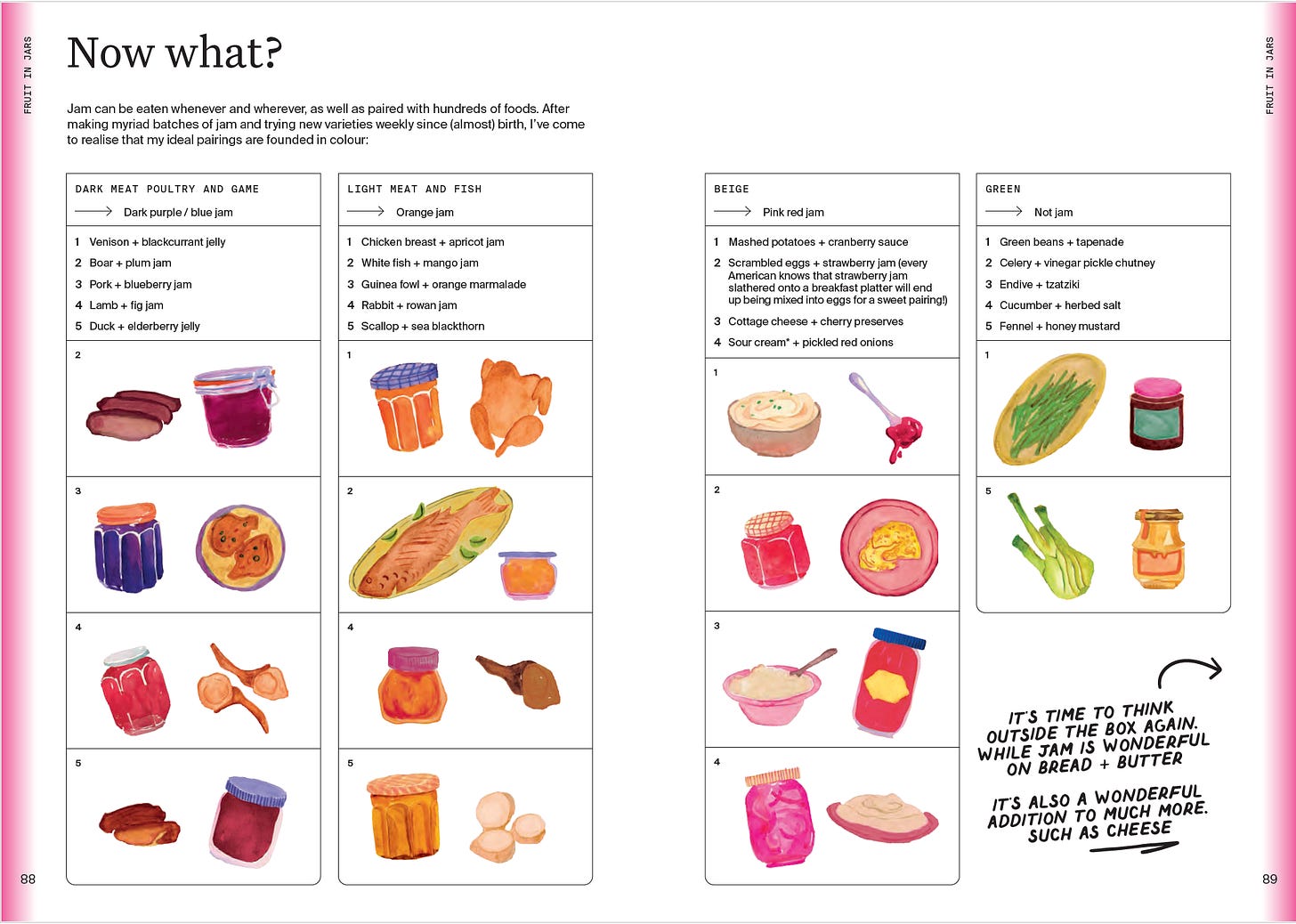
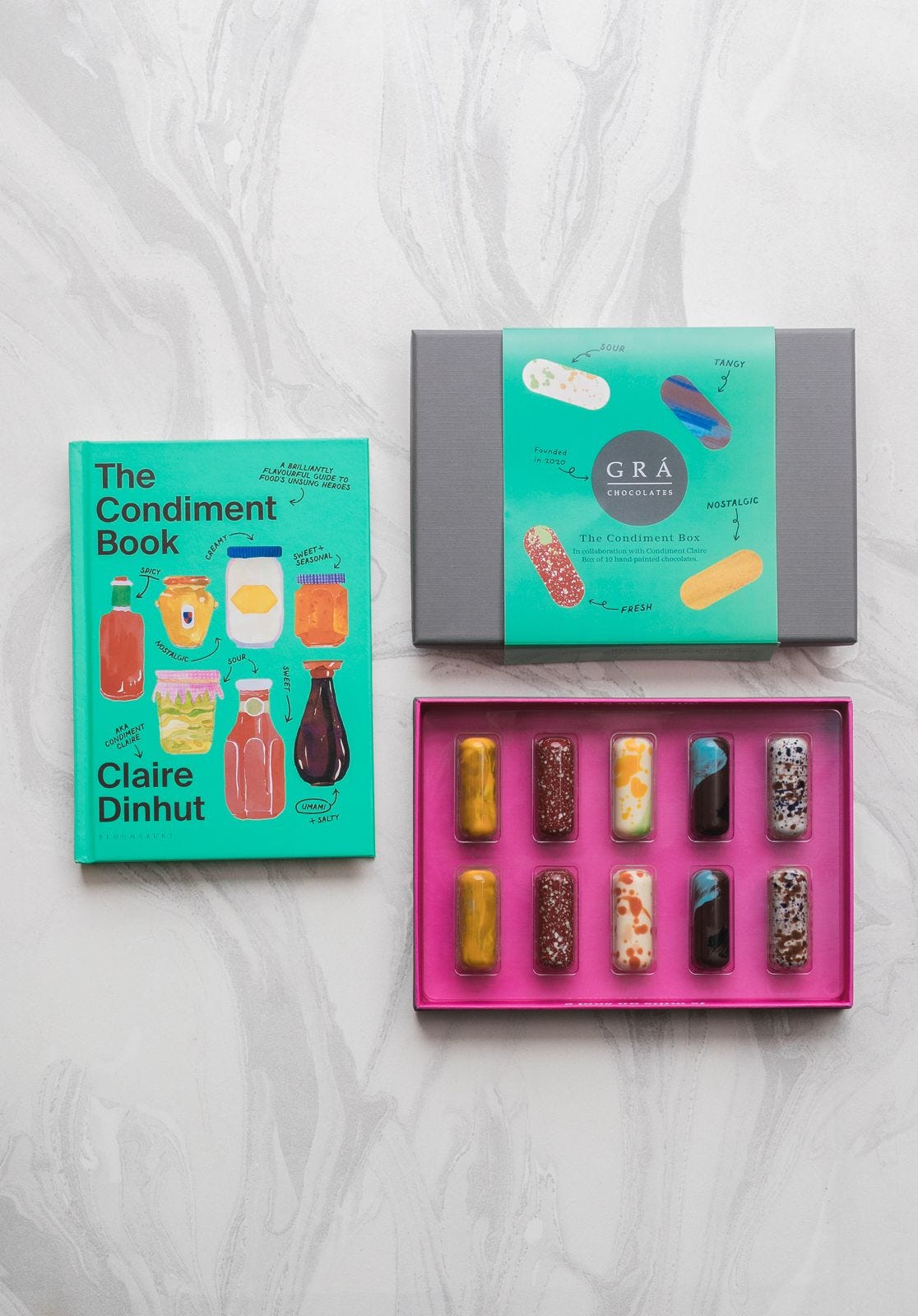
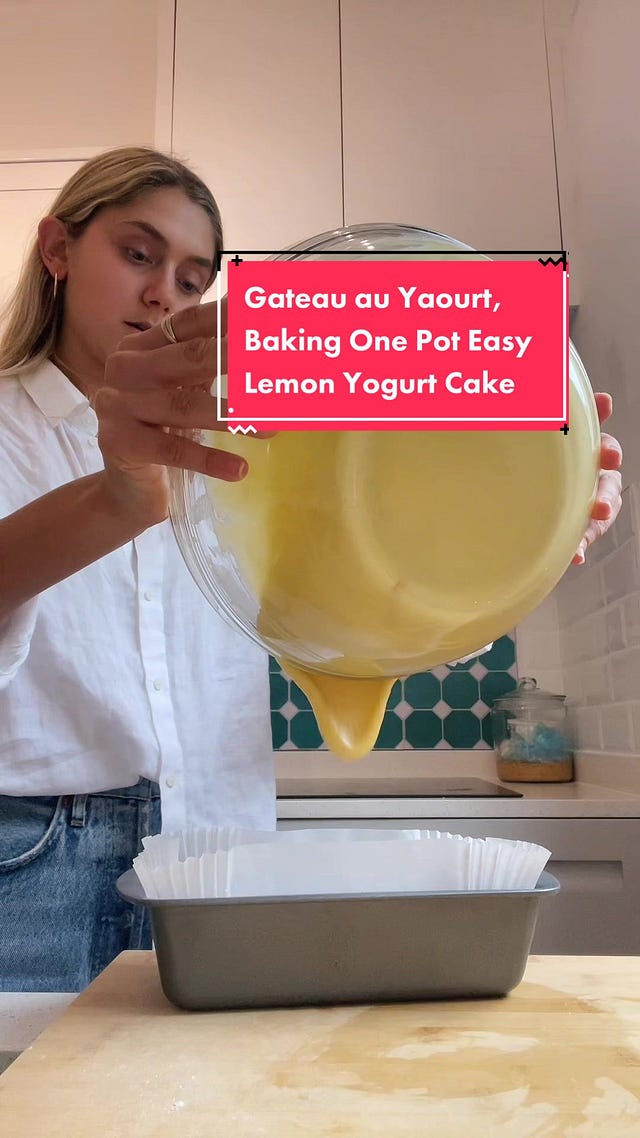
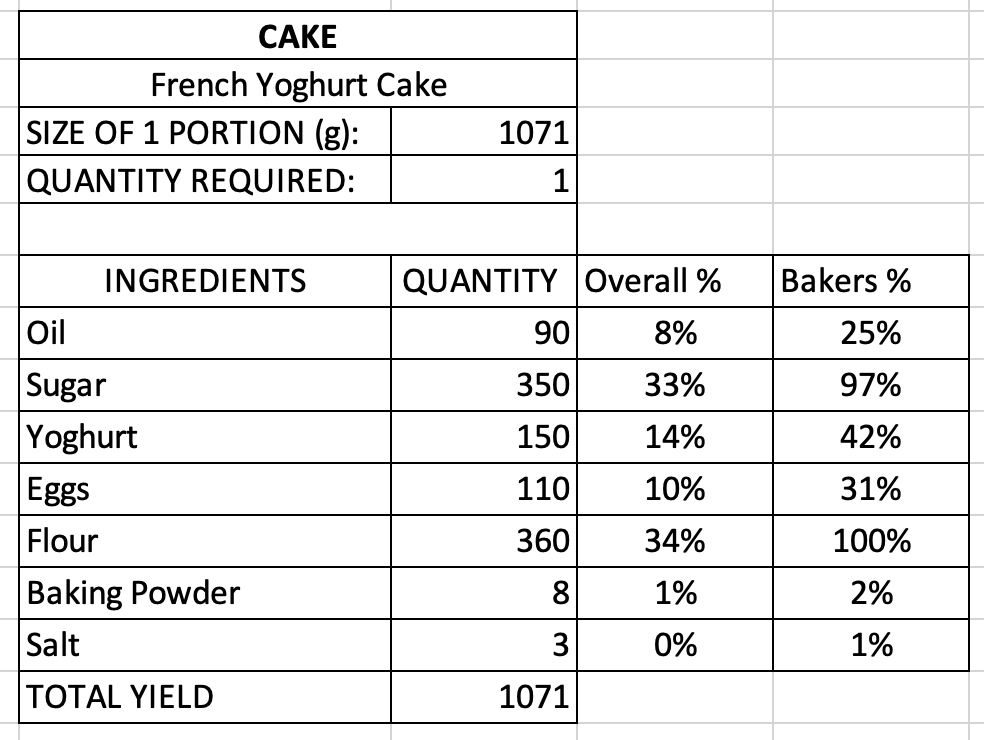
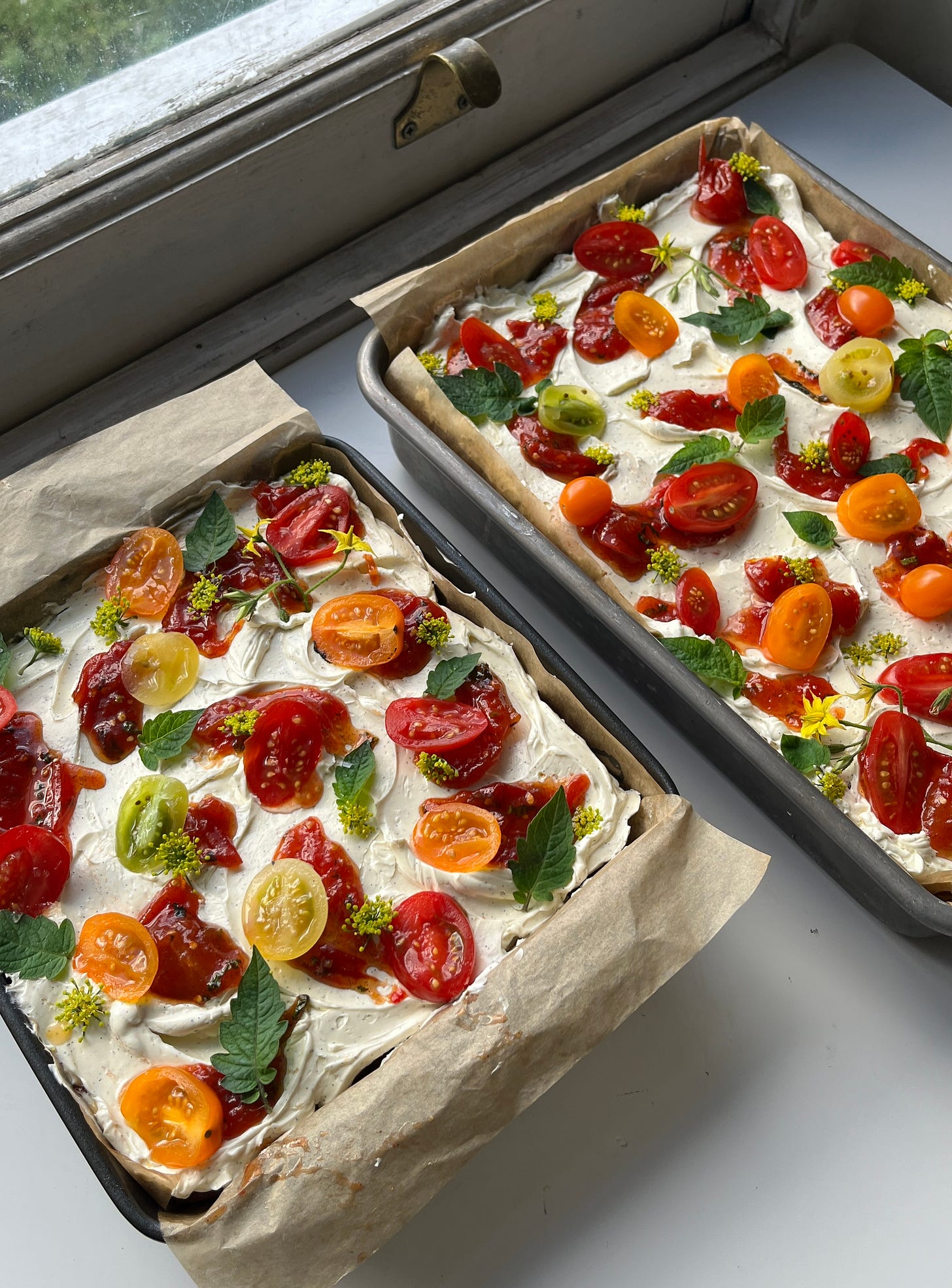
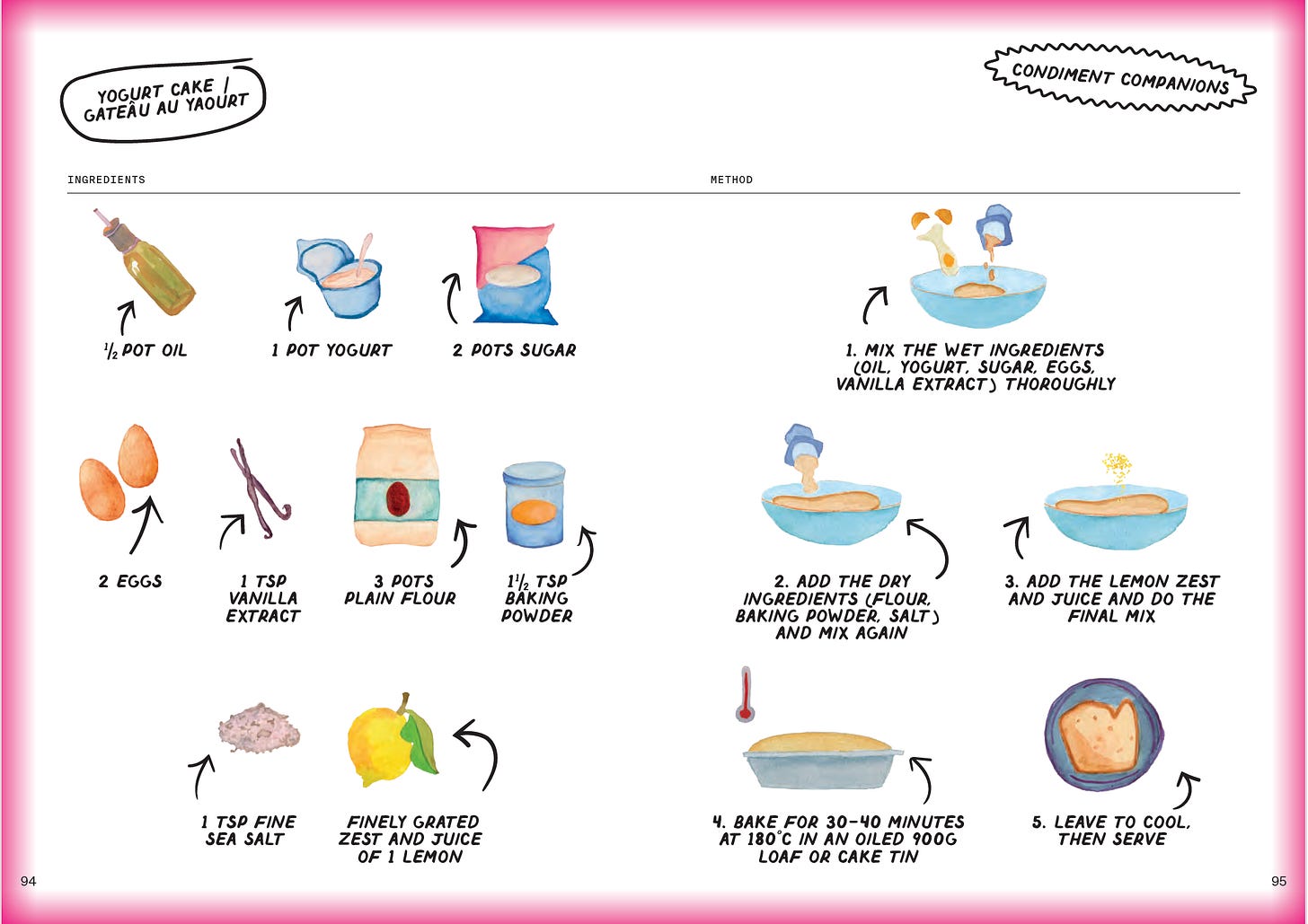
THANK YOU MY FRIEND NICOLA! It was so fun to be interviewed by you and be asked niche flavor questions. I hope you all love the yoghurt cake and the book as much as I do :)
The yogurt cake looks great! But to be honest I don’t quite understand the ‘pot’ measurements. Is this assuming the maker buys a 150g pot of yoghurt and uses this to measure everything? It’s be nice to know amounts if you are just using yogurt from a large container. Thanks!